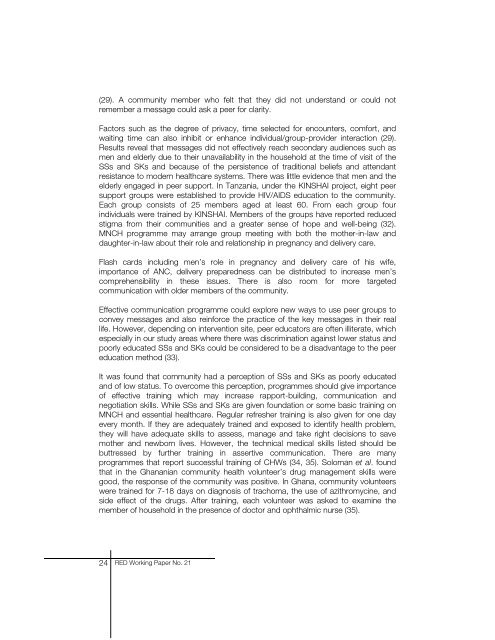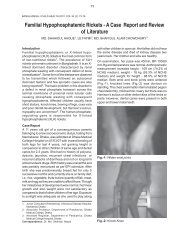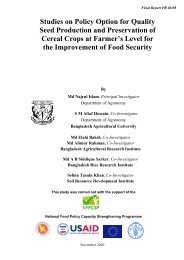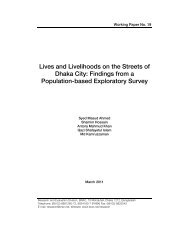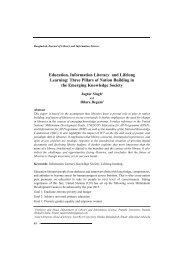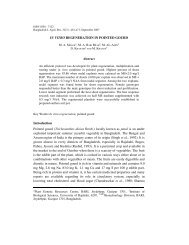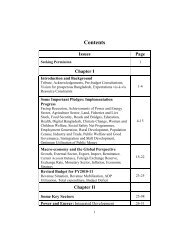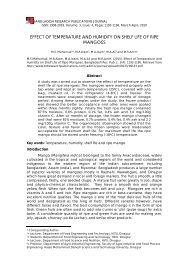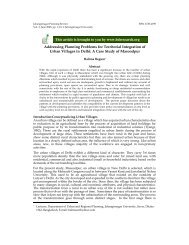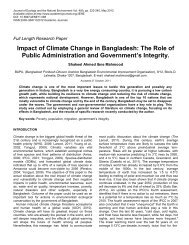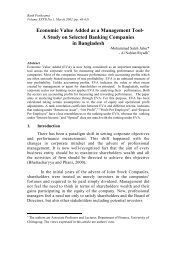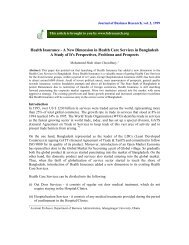Acceptability, Comprehensibility and Reported Influence - BRAC ...
Acceptability, Comprehensibility and Reported Influence - BRAC ...
Acceptability, Comprehensibility and Reported Influence - BRAC ...
Create successful ePaper yourself
Turn your PDF publications into a flip-book with our unique Google optimized e-Paper software.
(29). A community member who felt that they did not underst<strong>and</strong> or could not<br />
remember a message could ask a peer for clarity.<br />
Factors such as the degree of privacy, time selected for encounters, comfort, <strong>and</strong><br />
waiting time can also inhibit or enhance individual/group-provider interaction (29).<br />
Results reveal that messages did not effectively reach secondary audiences such as<br />
men <strong>and</strong> elderly due to their unavailability in the household at the time of visit of the<br />
SSs <strong>and</strong> SKs <strong>and</strong> because of the persistence of traditional beliefs <strong>and</strong> attendant<br />
resistance to modern healthcare systems. There was little evidence that men <strong>and</strong> the<br />
elderly engaged in peer support. In Tanzania, under the KINSHAI project, eight peer<br />
support groups were established to provide HIV/AIDS education to the community.<br />
Each group consists of 25 members aged at least 60. From each group four<br />
individuals were trained by KINSHAI. Members of the groups have reported reduced<br />
stigma from their communities <strong>and</strong> a greater sense of hope <strong>and</strong> well-being (32).<br />
MNCH programme may arrange group meeting with both the mother-in-law <strong>and</strong><br />
daughter-in-law about their role <strong>and</strong> relationship in pregnancy <strong>and</strong> delivery care.<br />
Flash cards including men’s role in pregnancy <strong>and</strong> delivery care of his wife,<br />
importance of ANC, delivery preparedness can be distributed to increase men’s<br />
comprehensibility in these issues. There is also room for more targeted<br />
communication with older members of the community.<br />
Effective communication programme could explore new ways to use peer groups to<br />
convey messages <strong>and</strong> also reinforce the practice of the key messages in their real<br />
life. However, depending on intervention site, peer educators are often illiterate, which<br />
especially in our study areas where there was discrimination against lower status <strong>and</strong><br />
poorly educated SSs <strong>and</strong> SKs could be considered to be a disadvantage to the peer<br />
education method (33).<br />
It was found that community had a perception of SSs <strong>and</strong> SKs as poorly educated<br />
<strong>and</strong> of low status. To overcome this perception, programmes should give importance<br />
of effective training which may increase rapport-building, communication <strong>and</strong><br />
negotiation skills. While SSs <strong>and</strong> SKs are given foundation or some basic training on<br />
MNCH <strong>and</strong> essential healthcare. Regular refresher training is also given for one day<br />
every month. If they are adequately trained <strong>and</strong> exposed to identify health problem,<br />
they will have adequate skills to assess, manage <strong>and</strong> take right decisions to save<br />
mother <strong>and</strong> newborn lives. However, the technical medical skills listed should be<br />
buttressed by further training in assertive communication. There are many<br />
programmes that report successful training of CHWs (34, 35). Soloman et al. found<br />
that in the Ghananian community health volunteer’s drug management skills were<br />
good, the response of the community was positive. In Ghana, community volunteers<br />
were trained for 7-18 days on diagnosis of trachoma, the use of azithromycine, <strong>and</strong><br />
side effect of the drugs. After training, each volunteer was asked to examine the<br />
member of household in the presence of doctor <strong>and</strong> ophthalmic nurse (35).<br />
24 RED Working Paper No. 21


